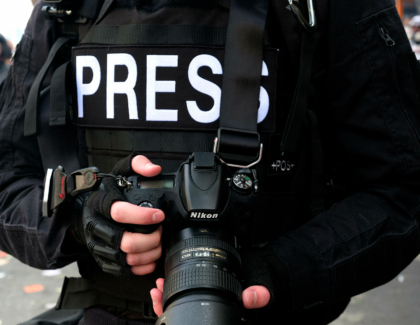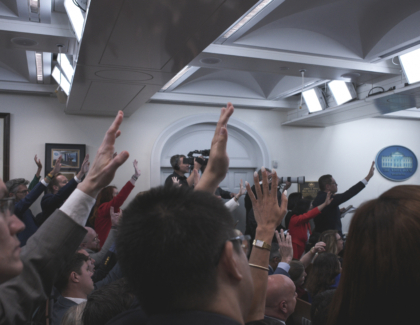Sign up for the daily CJR newsletter.
In June, the Republican National Committee posted a video that seemed to show Joe Biden wandering off from a group of world leaders at the Group of Seven summit. The video, which was widely distributed by conservative outlets (the New York Post: “Meander in Chief”), was edited to crop out who Biden was interacting with: a group of paratroopers, just done with a skydiving demonstration. It was one of several deceptively altered clips that circulated in conservative spaces that month—and were swiftly debunked by mainstream outlets. “‘Cheapfake’ Biden videos enrapture right-wing media, but deeply mislead,” the Washington Post wrote in a takedown. “Conservative media uses misleading camera angle of Biden to falsely claim that he was wandering aimlessly,” is how NBC News put it. Evaluating a slew of videos, including one from a D-Day commemoration where Biden appeared to have difficulty sitting down, the New York Times declared that they were posing “a major challenge for the president as he tries to persuade voters he has the energy for a second term.”
In the aftermath of the presidential debate, we now know that Biden was in fact struggling during this period, both physically and mentally. The debunkings that circulated in the weeks leading up to the debate got the facts in front of them right. But did they miss the bigger story?
I reached out to several of the outlets that covered the viral Biden videos, including the Washington Post, NBC News, Politifact, and the Times. Most of them declined to reassess their work, but Glenn Kessler, who took on the G7 video for the Post, felt he’d done his job. “Fact-checking is not supposed to say, This is a manipulated video, but there’s a quote-unquote larger truth here that Biden might be an old man,” he told me. “If you look at the Washington Post’s coverage, you can see the pieces done by the White House correspondents, by the opinion writers, that talk about the question of whether or not Joe Biden is showing signs of age. Fact-checks do not supplement the political reporting of the Washington Post, they complement it.”
Kessler’s view—that there’s a legitimate role for coverage narrowly focused on the confirmable facts at hand (whether far-fetched claims are justified by an edited video, say)—is widely held. But as Lucas Graves, a professor at the University of Wisconsin’s School of Journalism and Mass Communication and a leading researcher on political fact-checking, told me, this is in part because fact-checking is a poor instrument for trying to divine larger truths. “Fact-checking works best when fact-checkers are able to focus on discrete, very specific claims and assess their veracity,” he said. “They are often criticized for not getting the whole picture because when they find evidence of deception they really highlight that, and of course something can be deceptive but there can still be some truth to it.” He calls this the industry’s “Achilles’ heel.”
With the benefit of hindsight, it might have been possible to see hints of the president’s decline in both the edited and original videos. In some, Biden’s behavior is at least open to interpretation, as in a clip from a fundraiser in Los Angeles where he appears to freeze onstage for several seconds. (The White House condemned conservative news claims about that video; a Biden adviser said, “This did not happen.”) In the G7 video, Biden is interrupted by Italian prime minister Giorgia Meloni; he appears momentarily confused, and then is led back to the group of world leaders, who were assembling for a photograph. “When you bring in the fact that he was turning to the parachutist, that counters the idea that he was completely just wandering off,” Graves said. “Now, it’s a separate question whether he was out of step with the rest of the people participating.”
“There is a kernel of truth at the heart of what the edited version communicates that also might be visible in the unedited version, and that is Biden’s attention,” Keren Landman, a doctor and public health reporter at Vox, said. “His attention seems off.” She wasn’t involved in reporting on Biden’s condition until after the debate, when she wrote that his public appearance justified concerns about his well-being.
Graves has grappled with the limitations of fact-checking before, including in these pages. (I have, too, for our recent Election Issue: experts told me that debunking projects can undermine news organizations aiming to establish credibility, as audiences view them as gimmicky, and a diversion from reporters’ day-to-day work.) Ultimately, Graves doesn’t think that getting the whole story is something fact-checkers, at least as their task is defined now in many newsrooms, can achieve. “We wouldn’t want them, in the absence of more evidence, to engage in that much analysis or speculation,” he said. “We’re relying on them to establish the veracity of a specific thing.”
Other notable stories:
- Recently, a host on WURD, a Black-owned talk radio station in Philadelphia, resigned after acknowledging that the Biden campaign supplied the questions for an interview that she conducted with the president, and the Times reported that several other Black hosts had used versions of the same questions when interviewing Biden. Now CJR’s Josh Hersh assesses the costs of the episode, writing that “the Biden campaign would seem to have taken advantage of Black talk radio’s hospitality—and exploited the power it held over these small stations”; Sara Lomax, WURD’s CEO, said that “the ways in which political campaigns engage with Black media matter, as they can either lift our community up or cause greater harm.” (Hersh also interviewed Politico’s Eugene Daniels about coverage of Kamala Harris; you can listen here on our podcast The Kicker.)
- Since the recent assassination attempt on Donald Trump, speculation has swirled online as to whether he was really hit by a bullet; Trump and his former physician Ronny Jackson, who is now a member of Congress, said that he was, but his campaign has not released any official medical records, and some observers—including Christopher Wray, the director of the FBI—have suggested that Trump’s ear may have been cut by flying shrapnel. (In response, Trump blasted Wray on social media.) Amid the confusion, the Visual Investigations team at the Times assessed the available evidence and concluded that it “strongly suggests” Trump was indeed grazed by a bullet. (This morning, Politico shared the Times’ story with the caption: “The Zapruder Tape of our time.”)
- Recently, the Gateway Pundit, a right-wing website, filed for bankruptcy after two Georgia election workers and a former voting-tech executive sued it for defamation over its coverage of Trump’s 2020 election lies; Jim Hoft, the site’s founder, claimed that “progressive liberal lawfare attacks” had left him with no choice, but the plaintiffs accused him of trying to dodge accountability, as 404 Media reported at the time. This week, a federal judge sided with plaintiffs, ruling that the Gateway Pundit is solvent and had acted in “bad faith” to skirt the defamation suits. “That’s not a basis for bankruptcy relief,” the judge said, “it’s the justice system in operation.” CNN has the details.
- In other news about the media business, the Marshall Project, a nonprofit that covers the criminal justice system, launched “Investigate This!,” a resource-sharing initiative aimed at empowering local criminal justice coverage. Elsewhere, citizen journalists who cover municipal affairs in Massachusetts are suing a local community-access TV company that they say distorted copyright law in order to persuade YouTube to block clips of city meetings on their channel. And several news sites in the UK will now ask readers to consent to the “cookies” that allow advertisers to track their data, or else pay for access.
- And—after a joke spread online claiming that J.D. Vance, Trump’s running mate, once had sex with a couch—the Associated Press fact-checked it under the headline, “No, JD Vance did not have sex with a couch,” which, of course, just made the joke go even more viral. An AP spokesperson told Semafor’s Maxwell Tani that the article didn’t go through the agency’s proper editing processes and that it is looking into how it was published. Online, the joke very much lives on, as you’ll see if you open X this morning.
ICYMI: The cost of Biden’s dealings with Black talk radio
Has America ever needed a media defender more than now? Help us by joining CJR today.







